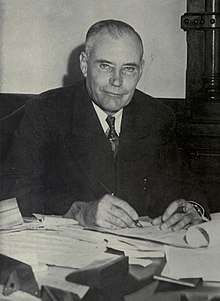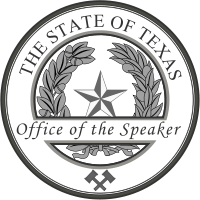Coke R. Stevenson
Coke Robert Stevenson (March 20, 1888 – June 28, 1975) was the 35th Governor of Texas from 1941 to 1947. He was the only 20th-century Texan politician to serve as Speaker of the Texas House of Representatives, as lieutenant governor, and then as governor. In 1966, Recorded Texas Historic Landmark marker number 5118, honoring Stevenson, was placed on the Kimble County Courthouse grounds in Junction, Texas.[1]
Coke R. Stevenson | |
|---|---|
 | |
| 35th Governor of Texas | |
| In office August 4, 1941 – January 21, 1947 | |
| Lieutenant | Vacant John L. Smith |
| Preceded by | W. Lee O'Daniel |
| Succeeded by | Beauford H. Jester |
| 31st Lieutenant Governor of Texas | |
| In office January 17, 1939 – August 4, 1941 | |
| Governor | W. Lee O'Daniel |
| Preceded by | Walter Frank Woodul, Sr. |
| Succeeded by | John Lee Smith |
| Member of the Texas House of Representatives from District 86 | |
| In office January 8, 1929 – January 10, 1939 | |
| Preceded by | Roscoe Runge |
| Succeeded by | Claude Henry Gilmer |
| Personal details | |
| Born | March 20, 1888 Mason County, Texas, U.S. |
| Died | June 28, 1975 (aged 87) San Angelo, Texas, U.S. |
| Resting place | Stevenson Family Ranch Cemetery, Telegraph, Texas |
| Political party | Democrat (until c. 1949) |
| Spouse(s) | Fay Wright
( m. 1912; died 1942)Marguerite King-Heap ( m. 1954) |
| Children | 2 |
| Profession | Rancher |
Early life
Stevenson was born near the geographic center of Texas, in Mason County, to Robert Milton and Virginia Hurley Stevenson. His parents named him for Governor Richard Coke.[2] As a teenager, Stevenson went into the business of hauling freight with a six-horse wagon. While hauling freight, he studied bookkeeping by the light of his nighttime campfires as part of a plan to begin a business or banking career. Offered a position as a janitor for the Junction State Bank, Stevenson accepted and sold his freight hauling business. He was soon promoted to bookkeeper, and he became the bank's cashier when he was twenty.
Stevenson studied law at night in the office of attorney and judge Marvin Ellis Blackburn while working at the bank, and attained admission to the bar in 1913.[3]
Early career
In 1913, Stevenson organized and became president of the First National Bank in Junction, the seat of Kimble County. He also became active in several other business ventures, including a warehouse, movie theater, hardware store, automobile dealership, newspaper, drug store, and hotel. Stevenson was Kimble County Attorney from 1914 to 1918 and Kimble County Judge, the county's chief administrative and executive position, from 1919 to 1921.
Public service
In 1928, Stevenson was elected to the Texas House of Representatives as a conservative Democrat, and served there from 1929 until 1939. In 1933, he was elected Speaker of the House; he was re-elected in 1935, becoming the first person in Texas history to serve two consecutive terms as Speaker. After five terms in the House, Stevenson was elected lieutenant governor in 1938, serving under Governor W. Lee "Pappy" O'Daniel.
Stevenson succeeded to the governorship on August 4, 1941, when O'Daniel resigned to take a seat in the U.S. Senate, which he won in a special election. In dramatic contrast to the flamboyant and unpredictable O'Daniel, Stevenson's approach was so conservative and taciturn that his critics accused him of doing nothing. Stevenson was elected to a full term in 1942, winning the Democratic primary with 69% of the vote and being unopposed in the general election. He was elected to a second term in 1944, effectively unopposed.[4] When Stevenson left the governorship in January 1947, he was the longest-serving governor in the history of Texas and had presided over a broad and deep economic recovery during the years of World War II.
In 1948, Stevenson was a candidate the U.S. Senate in a special election. He led the Democratic primary with 39.7% to 33.7% against Congressman Lyndon B. Johnson of Austin. A third candidate was George Peddy of Houston, originally from Shelby County in East Texas, who had been a write-in candidate for the Senate in 1922 but was defeated by Democratic nominee Earle Bradford Mayfield.[5] With the top two finishers advancing to a runoff election, Peddy and several minor candidates were eliminated from contention.
In the hotly contested runoff between Stevenson and Johnson, Johnson won by only 87 votes out of 988,295 cast – one of the closest results in a senatorial election in U.S. history.[6] (As there was only a weak Republican Party in Texas at the time, winning the Democratic primary was tantamount to election.)
Stevenson challenged the result on the grounds of ballot stuffing alleged to have occurred in a single precinct, which involved 203 disputed votes from Jim Wells County. The Democratic State Central Committee sustained Johnson's apparent victory by a 29–28 vote. Stevenson was granted an injunction by the federal district court, which barred Johnson from the general election ballot. However, Supreme Court Associate Justice Hugo Black, sitting as a circuit justice, ruled that the federal district court lacked jurisdiction, and that the question was for the Central Committee to decide.[7] He ordered the injunction stayed, and his ruling was upheld by the Supreme Court.[8]
After the loss to Johnson, Stevenson retired to Junction. Disenchanted with the Democratic Party, he supported Republican Jack Porter against Johnson in the general election[9][10] and continued to support Republicans for the rest of his life, including John G. Tower for the Senate and Richard M. Nixon and Barry Goldwater for the presidency.
In 1964, Stevenson met at his ranch with the Republican gubernatorial nominee Jack Crichton of Dallas. He did not specifically endorse Crichton over John B. Connally, who had worked for Johnson against Stevenson in the disputed 1948 Democratic primary, but meeting with Crichton was seen as a sign of Stevenson's support.
Personal life and death
On December 24, 1912, Stevenson married Fay Wright. The couple had one son, Coke Stevenson Jr. Fay died on January 3, 1942.
On January 16, 1954, Stevenson married Marguerite King Heap. Marguerite had one son, Dennis, from her marriage to Gordon Marshall Heap, who died in action during World War II. Coke and Marguerite had one daughter, Jane Stevenson Murr Chandler. Marguerite died March 24, 2010 in Ozona, Texas.[11][12]
Stevenson died on June 28, 1975, at Shannon Memorial Hospital in San Angelo, Texas.
Historiography
Stevenson's character became a subject of historical discussion after the publication of Means of Ascent, the second volume of Robert Caro's best-selling biography of Lyndon Johnson, which covers the disputed 1948 election. Caro portrayed Stevenson as an honorable statesman and reluctant office-seeker, in contrast to the venal and intensely ambitious Johnson.[13]
According to Johnson biographer Robert Dallek, "Coke Stevenson was a terribly reactionary man. First of all, on civil rights, in 1942, a black Texan was lynched in Texarkana and Stevenson gave very little public response against this. And when he was asked privately about it, his comment was -- 'You know,' he said, 'these Negroes sometimes do things which provoke whites to such violence.'"[14]
In the April 26, 1990 issue of the New York Review of Books, Pulitzer Prize-winning author Garry Wills criticized Caro's characterization of the former Texas governor as anti-corrupt and claimed that in his gubernatorial campaigns, Stevenson had also likely forged a significant number of votes in the very same corrupt counties which aided Johnson in 1948.[15] In one Texas gubernatorial primary, Stevenson obtained 3,310 votes in the notorious Duval County while five of his rivals split the remaining 17 votes that were tallied.[15] In another such primary, an opponent of Stevenson won a south Texas county by a vote of 3000 to five, and then lost to Stevenson by exactly the same margin in the ensuing runoff because of a dispute with the county's political boss.[15]
Caro responded to these criticisms in an essay in the New York Times Book Review of February 2, 1991.[16][17] This essay also appeared as an afterword to the paperback edition of Means of Ascent.
References
- "Coke Stevenson Recorded Texas Historic Landmark". Texas Historical Commission. Retrieved February 16, 2011.
- Robert A. Caro: The Years of Lyndon Johnson: Means of Ascent, p. 146. New York 1991, Vintage. ISBN 978-0-679-73371-3
- Robert Dallek, Lone Star Rising: Lyndon Johnson and His Times, 1908-1960, Volume 1, 1991, page 315
- Congressional Quarterly's Guide to U.S. Elections. Congressional Quarterly. 1985. pp. 529, 1087.
- "George Edwin Bailey Peddy". tshaonline.org. Retrieved June 18, 2013.
- Congressional Quarterly's Guide to U.S. Elections. Congressional Quarterly. 1985. p. 1101.
- Martin Tolchin (February 11, 1990). "How Johnson Won Election He'd Lost". The New York Times. Retrieved April 12, 2012.
- Harvard Law Review, Vol. 62, No. 2 (Dec., 1948), pp. 311-313
- "Oust Left-Wingers, Asks GOP Nominee". Abilene Reporter-News. Abilene, TX. Associated Press. September 19, 1948. p. 10 – via Newspapers.com.
- "Porter Assails Johnson Record". Lubbock Morning Avalanche. Lubbock, TX. Associated Press. October 13, 1948. p. 1 – via Newspapers.com.
- "Marguerite K. Stevenson obituary". San Angelo Standard-Times. San Angelo, TX. May 26, 2010. Retrieved November 12, 2019 – via Legacy.com.
- Branda, Eldon S. "Coke Robert Stevenson". Handbook of Texas Online. Retrieved February 16, 2011.Texas State Historical Association
- Caro, Robert A. (1990). "The Story of Coke Stevenson". Means of Ascent. The Years of Lyndon Johnson. New York: Alfred A. Knopf, Inc. pp. 145–178. ISBN 0-394-52835-2.
- "American Experience: LBJ". PBS. September 30, 1991.
- Garry Willis (April 26, 1990). Monstre Désacré. New York Review of Books. Retrieved February 20, 2014.
- Caro, Robert A. (February 3, 1991). "My Search for Coke Stevenson". The New York Times Book Review. Archived from the original on April 18, 2009. Retrieved April 10, 2013.
- Caro, Robert A. (February 3, 1991). "My Search for Coke Stevenson". The New York Times. Retrieved April 10, 2013.
magazines and newspapers made statements about Coke Stevenson, Lyndon Johnson's opponent in the 1948 United States Senate campaign, for which I believe there is no factual basis. Some of these articles, no doubt inadvertently, repeated allegations and rumors circulated in 1948 by Johnson and his followers in their effort to undermine Stevenson's reputation -- allegations and rumors I also believe to be without factual basis.
External links
- Coke Robert Stevenson from the Handbook of Texas Online
- Historic photographs of Coke R. Stevenson, hosted by the Portal to Texas History
- Tex. Legis. Council, Presiding Officers of the Texas Legislature: 1846-2016 (2016)
- Coke R. Stevenson at Find a Grave
| Party political offices | ||
|---|---|---|
| Preceded by W. Lee O'Daniel |
Democratic nominee for Governor of Texas 1942, 1944 |
Succeeded by Beauford H. Jester |
| Texas House of Representatives | ||
| Preceded by Roscoe Runge |
Member of the Texas House of Representatives from District 86 (Junction) 1929–1939 |
Succeeded by Claud Henry Gilmer |
| Political offices | ||
| Preceded by Fred Hawthorne Minor |
Speaker of the Texas House of Representatives 1933–1937 |
Succeeded by Robert Emmett Morse |
| Preceded by Walter Frank Woodul, Sr |
Lieutenant Governor of Texas January 17, 1939 – August 4, 1941 |
Succeeded by John Lee Smith |
| Preceded by W. Lee O'Daniel |
Governor of Texas August 4, 1941 – January 21, 1947 |
Succeeded by Beauford H. Jester |


